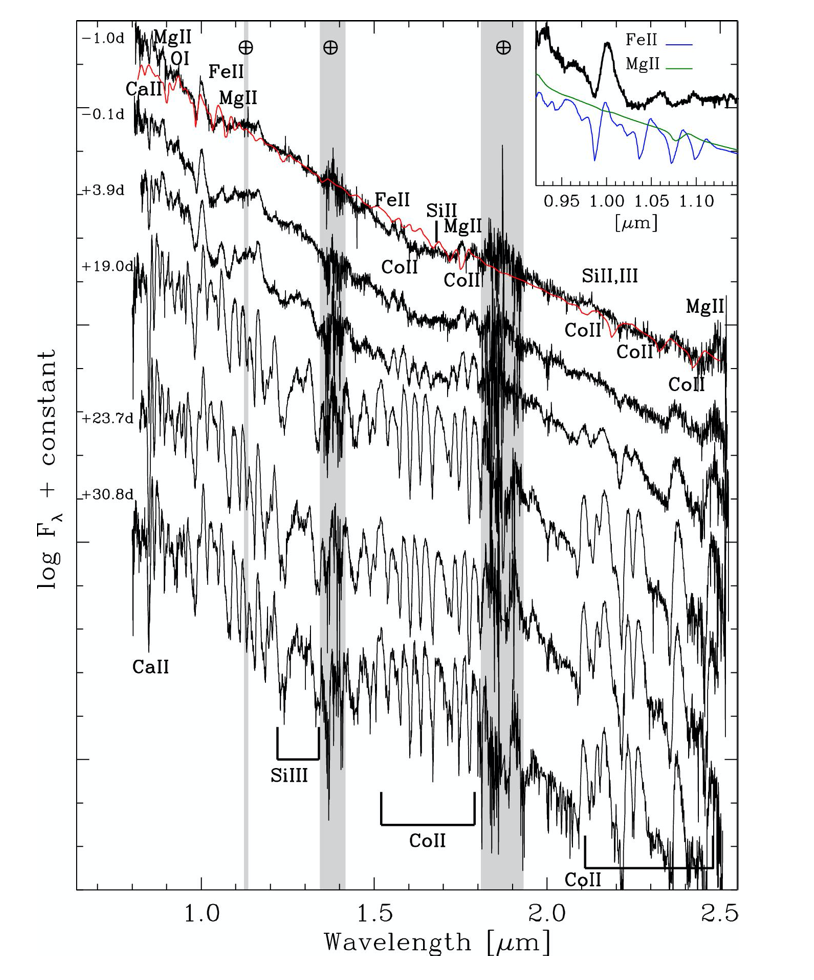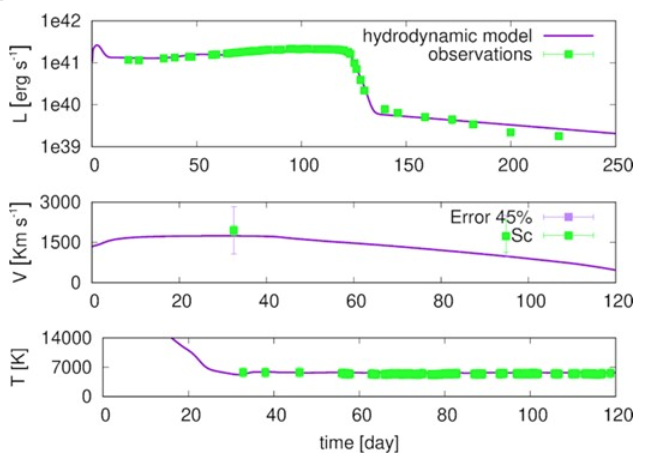Type Iax Supernovae
In the last decade, the discovery of several peculiar Type Ia SNe has drawn the attention
to the photometric and spectroscopic diversity in this class formed by otherwise
homogeneous transients. SNe Iax are the largest class of peculiar thermonuclear SNe (with over 50 members known so far), whose main characteristics are:
- a lower luminosity than normal SNe Ia (-13 > MV > -19), and
a fast rise (~10 to 20 days) to the maximum light;
- lower velocity for the ejected material (~2000-6000 km/s) compared to classical Type Ia SNe;
- early spectra dominated by Fe-group elements (strong FeII, FeIII; CoII in the JHK-bands); IMEs, such as Si, S, and Ca are identified, but these features are weaker than
those observed in normal SNe Ia.
For a comprehensive review on Type Iax events, see Jha 2017, Handbook of Supernovae (Springer).

Type Iax are unique among all SNe in their late-time spectral properties. These spectra show both permitted and forbidden emission features, never becoming fully nebular.
Regarding the progenitors, pre-explosion HST deep images for SN 2012Z (McCully et al. 2014, Nature, 512) show a luminous and blue source consistent with an He-star
companion to a C/O WD system; progenitor non-detection for 2014ck (Tomasella et al. 2016, MNRAS 459), SNe 2008ge and 2014dt (Foley et al. 2010, AJ, 140; 2015, ApJ, 798)
rules out the most luminous/massive stars. However, the diversity within this class of transients cannot be reduced to a one-parameter description and this may imply that
distinct progenitors and/or explosion mechanisms are involved, despite the overall similarity of the main observables.
Fig. 1 NIR spectral sequence of SN 2014ck (Tomasella et al. 2016, MNRAS 459, 1018) obtained with the Gemini N Telescope (+GNIRS).
Phases, labelled on the left, are relative to V-band maximum. Spectra at +19d and later are strongly dominated by Co II lines, which provide a clear link to SNe Ia.
Publications:
- Tomasella et al. 2020, MNRAS, 496, 1132
- Tomasella et al. 2016, MNRAS, 459, 1018
- Stritzinger et al. 2015, A&A, 573, A2
- Stritzinger et al. 2015, A&A, 561, A146
- Valenti et al. 2009, Nature, 459, 674
Faint and slow Type II SNe
Faint and slow type II SNe is a group of core-collapse SNe showing the following specific observed properties:
- they are faint at all phases (-13 > MV > -15);
- they show low velocity ejecta (i.e. low kinetic energy, < 1050 erg);
- they eject low amounts of 56Ni (of the order of a few 10-3 Msun);
- they are characterized by long-lasting (over 4 months), flat plateaux.

Fig. 2 Comparison between observed data of a subluminous Type IIP SN and the outcome of an hydrodynamic model. Figure from Valerin et al. 2022.
Besides the lowest-luminosity Type II-P events (Pastorello et al. 2004, MNRAS, 347, 74; Spiro et al. 2014, MNRAS, 439, 2873), several objects were discovered showing slow ejecta but intermediate-luminosity light curves (SNe 2008in, 2009N, 2009js, 2009ib, 2010id, 2012A, 2013am, 2013K, etc.). These Type IIP SNe are bridging the gap observational between normal and faint SNe SNe IIP. While we observe a wide range of observational parameters from low-luminosity to standard SNe IIP, the above parameters are somewhat correlated, with fainter objects ejecting less 56Ni, having lover-velocity ejecta, and a lower radiated energy. The reason of the wide range of physical parameters spanned by SNe IIP remains unclear. This is even more puzzling given that the inferred masses of the observed progenitor of sub-luminous SNe IIP are very similar or only marginally smaller than the masses of the progenitors of normal SNe IIP (e.g., Smartt 2009, ARA&A, 47, 63).
The main focus of this project is the characterization of the different
types of faint and slow (in the sense of extremely low ejecta velocities)
SNe on the basis of their observational parameters, inferred
through the photometric monitoring, the spectroscopic evolution, the theoretical modelling (Fig. 2)
and the detection of their progenitor stars in archive images.
Publications:
- Valerin et al. 2022, MNRAS, 513, 4983
- Reguitti et al. 2021, MNRAS, 501, 1059
- Spiro et al. 2014, MNRAS, 439, 2873
- Pastorello et al. 2012, A&A, 537, A141
- Pastorello et al. 2009, A&A, 500, 1013
- Pastorello et al. 2009, MNRAS, 394, 2266
- Pastorello et al. 2006, MNRAS, 370, 1752
- Pastorello et al. 2004, MNRAS, 347, 74
- Benetti et al. 2001, MNRAS, 322, 361
- Turatto et al. 1998, ApJ, 498, L129
Lina Tomasella (INAF-OAPd), Stefano Benetti (INAF-OAPd), Enrico Cappellaro (INAF-OAPd), Nancy Elias-Rosa (INAF-OAPd), Andrea Pastorello (INAF-OAPd), Giorgio Valerin (UniPd)
Other researchers involved:
Maximilian Stritzinger (Aarhus Univ. Denmark), Luca Zampieri (INAF-OAPd), Maria Letizia Pumo (Catania Univ.), Andrea Reguitti (Andres Bello Univ.), Massimo Turatto (INAF-OAPd)